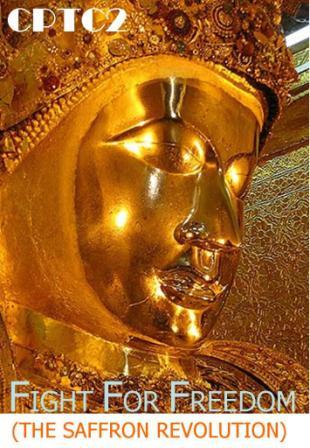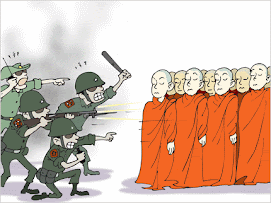Rangoon Under Siege
September 27, 2007
Rangoon was covered with gunfire smoke on Thursday as security forces and armed military troops used an iron fist to disperse tens of thousands of demonstrators in the second day of the Burmese junta's crackdown on the largest democracy uprising in 20 years. State media reported Thursday evening that nine protesters were killed.
Witnesses in Rangoon believed that the death toll would be higher. Security forces attempted to disperse tens of thousands of people gathered near Sule Pagoda in Rangoon and South Okkalapa Township on Thursday afternoon, witnesses said. The report could not be independently confirmed. Scores of people were beaten by security forces.
Troops fired directly into protesting crowds, using automatic weapons on at least one occasion. Warning shots were also fired above the heads of protesters as an estimated 70,000 anti-government demonstrators braved the overpowering force of the troops and security forces.
Protesters were outraged at security forces following an overnight raid on at least three Buddhist monasteries. Soldiers reportedly beat up and arrested about 700 monks, who had spearheaded the largest challenge to the junta since a failed democracy uprising 19 years ago. One monk reportedly died.
The Japanese Embassy reported on Thursday evening that a Japanese photojournalist died in the gunfire. Pictures released on the Internet show the journalist lying on his back in the street with one hand raised up holding his camera. A soldier wearing flip flops is pointing his rifle at the journalist. A second photograph shows the journalist's face contorted and his arm now rests on the ground, apparently shot a second time at point blank range. The photojournalist was Kanji Nagai, 51, according to the Japanese video news agency APF News.
It is believed that security forces issued a 10-minute warning to the pro-democracy demonstrators to disperse from the area around Sule Pagodas or face "extreme action."
The gunfire came on the second day of a bloody crackdown that began on Wednesday when five monks died from gunfire or were beaten to death by security forces.
In other news, a number of foreign ambassadors are reportedly now in Naypyidawto discuss the junta's actions during the crackdown. Some Western governments are said to be considering pulling their embassies out of Burma to protest against the military government's actions.
A spokesman for the monks told the international media on Thursday they are demanding the junta lower fuel prices, release Aung San Suu Kyi from house arrest and begin a real dialogue with the democratic opposition leaders in the country. Similar demands have been made by many countries and organizations in the recent past.
Overnight, more monks were surrounded and attacked in at least three monasteries. One monk reportedly died and many were beaten. The hallways and rooms of one monastery were splattered with blood. An estimated 700 monks were taken away by security forces.
Thousands of protesters who were dispersed when soldiers fired into the demonstrators near the center of Rangoon on Thursday regathered and then walked to Tamwe Township in eastern Rangoon, a protester told The Irrawaddy. He said most of the protesters were determined to continue the demonstrations despite the danger. After troops fired on the crowd, about 100 people were arrested and taken away.
Later in the day, protesters reached Tamwe Township where they were again confronted by security forces who surrounded the protestors and fired into the crowd.
A short while later, bloggers and e-mail reports said that military vehicles were driving through the town firing randomly into peaceful crowds, apparently in an effort to spark terror throughout the city.
Soldiers also entered Traders Hotel situated in the heart of Rangoon near Sule pagoda on Thursday afternoon and searched it room by room, according to sources. It was thought the soldiers were searching for foreign journalists suspected of capturing video from a hotel room and reporting clandestinely on the crackdown to international media.
At least three monasteries were stormed under gunfire by troops and riot police early Thursday morning, reportedly killing one monk and injuring many others. Only monastery sick-bay patients were left alone as the monks were beaten, kicked and forced out of the monasteries and into waiting vehicles. It was not known where they were taken.
In South Okkalapa Township, one center of resistance in the 1988 popular uprising, tens of thousands of angry residents besieged security forces guarding New Kyar Yan monastery. The monastery was broken into by troops and riot police during the night and around 200 monks beaten and arrested.
“The troops are deploying themselves as if for action,” an eyewitness told The Irrawaddy.
An army truck broke down the main gate of Ngwe Kyar Yan monastery in the early hours of Thursday morning and warning shots were fired as the monks were rounded up, a local welfare worker told The Irrawaddy.
"The whole compound of the monastery is chaotic. Windows were smashed, bullet casings littered the ground, and blood stained the concrete floor," he said.
Five hundred monks were arrested after security forces broke forcibly into Mogaung monastery in Yankin Township, one eyewitness said.
Some who avoided arrest returned after daybreak, bleeding from wounds to their shaven heads. A few said they had got away by climbing into trees around the monastery.
Maggin monastery in western Rangoon, where HIV patients are cared for was also raided. Witnesses said that soldiers and riot police stormed in, beating up and hauling away four monks, including the abbot and four people caring for HIV patients. Burma’s monasteries are hotbeds of the pro-democracy movement. The current raids seem to be in an apparent attempt to prevent further demonstrations, which have been spearheaded by the Buddhist monks.
The security forces fired at protesters for the first time on Wednesday in street protests that have grown over the past month into the biggest demonstrations against Burma's military rulers since 1988.
Rangoon was covered with gunfire smoke on Thursday as security forces and armed military troops used an iron fist to disperse tens of thousands of demonstrators in the second day of the Burmese junta's crackdown on the largest democracy uprising in 20 years. State media reported Thursday evening that nine protesters were killed.
Witnesses in Rangoon believed that the death toll would be higher. Security forces attempted to disperse tens of thousands of people gathered near Sule Pagoda in Rangoon and South Okkalapa Township on Thursday afternoon, witnesses said. The report could not be independently confirmed. Scores of people were beaten by security forces.
Troops fired directly into protesting crowds, using automatic weapons on at least one occasion. Warning shots were also fired above the heads of protesters as an estimated 70,000 anti-government demonstrators braved the overpowering force of the troops and security forces.
Protesters were outraged at security forces following an overnight raid on at least three Buddhist monasteries. Soldiers reportedly beat up and arrested about 700 monks, who had spearheaded the largest challenge to the junta since a failed democracy uprising 19 years ago. One monk reportedly died.
The Japanese Embassy reported on Thursday evening that a Japanese photojournalist died in the gunfire. Pictures released on the Internet show the journalist lying on his back in the street with one hand raised up holding his camera. A soldier wearing flip flops is pointing his rifle at the journalist. A second photograph shows the journalist's face contorted and his arm now rests on the ground, apparently shot a second time at point blank range. The photojournalist was Kanji Nagai, 51, according to the Japanese video news agency APF News.
It is believed that security forces issued a 10-minute warning to the pro-democracy demonstrators to disperse from the area around Sule Pagodas or face "extreme action."
The gunfire came on the second day of a bloody crackdown that began on Wednesday when five monks died from gunfire or were beaten to death by security forces.
In other news, a number of foreign ambassadors are reportedly now in Naypyidawto discuss the junta's actions during the crackdown. Some Western governments are said to be considering pulling their embassies out of Burma to protest against the military government's actions.
A spokesman for the monks told the international media on Thursday they are demanding the junta lower fuel prices, release Aung San Suu Kyi from house arrest and begin a real dialogue with the democratic opposition leaders in the country. Similar demands have been made by many countries and organizations in the recent past.
Overnight, more monks were surrounded and attacked in at least three monasteries. One monk reportedly died and many were beaten. The hallways and rooms of one monastery were splattered with blood. An estimated 700 monks were taken away by security forces.
Thousands of protesters who were dispersed when soldiers fired into the demonstrators near the center of Rangoon on Thursday regathered and then walked to Tamwe Township in eastern Rangoon, a protester told The Irrawaddy. He said most of the protesters were determined to continue the demonstrations despite the danger. After troops fired on the crowd, about 100 people were arrested and taken away.
Later in the day, protesters reached Tamwe Township where they were again confronted by security forces who surrounded the protestors and fired into the crowd.
A short while later, bloggers and e-mail reports said that military vehicles were driving through the town firing randomly into peaceful crowds, apparently in an effort to spark terror throughout the city.
Soldiers also entered Traders Hotel situated in the heart of Rangoon near Sule pagoda on Thursday afternoon and searched it room by room, according to sources. It was thought the soldiers were searching for foreign journalists suspected of capturing video from a hotel room and reporting clandestinely on the crackdown to international media.
At least three monasteries were stormed under gunfire by troops and riot police early Thursday morning, reportedly killing one monk and injuring many others. Only monastery sick-bay patients were left alone as the monks were beaten, kicked and forced out of the monasteries and into waiting vehicles. It was not known where they were taken.
In South Okkalapa Township, one center of resistance in the 1988 popular uprising, tens of thousands of angry residents besieged security forces guarding New Kyar Yan monastery. The monastery was broken into by troops and riot police during the night and around 200 monks beaten and arrested.
“The troops are deploying themselves as if for action,” an eyewitness told The Irrawaddy.
An army truck broke down the main gate of Ngwe Kyar Yan monastery in the early hours of Thursday morning and warning shots were fired as the monks were rounded up, a local welfare worker told The Irrawaddy.
"The whole compound of the monastery is chaotic. Windows were smashed, bullet casings littered the ground, and blood stained the concrete floor," he said.
Five hundred monks were arrested after security forces broke forcibly into Mogaung monastery in Yankin Township, one eyewitness said.
Some who avoided arrest returned after daybreak, bleeding from wounds to their shaven heads. A few said they had got away by climbing into trees around the monastery.
Maggin monastery in western Rangoon, where HIV patients are cared for was also raided. Witnesses said that soldiers and riot police stormed in, beating up and hauling away four monks, including the abbot and four people caring for HIV patients. Burma’s monasteries are hotbeds of the pro-democracy movement. The current raids seem to be in an apparent attempt to prevent further demonstrations, which have been spearheaded by the Buddhist monks.
The security forces fired at protesters for the first time on Wednesday in street protests that have grown over the past month into the biggest demonstrations against Burma's military rulers since 1988.






























No comments:
Post a Comment